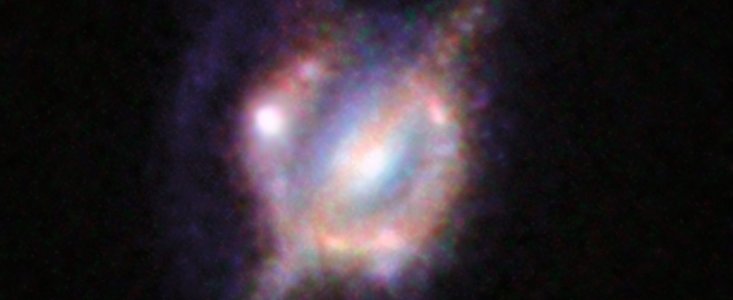*ArXiv pre-print http://arxiv.org/abs/1406.4859http://www.eso.org/public/news/eso1426/
Best View Yet of Merging Galaxies in Distant Universe
Using the Atacama Large Millimeter/submillimeter Array (ALMA), and many other telescopes on the ground and in space, an international team of astronomers has obtained the best view yet of a collision that took place between two galaxies when the Universe was only half its current age. They enlisted the help of a galaxy-sized magnifying glass to reveal otherwise invisible detail. These new studies of the galaxy H-ATLAS J142935.3-002836 have shown that this complex and distant object looks like the well-known local galaxy collision, the Antennae Galaxies.
This research was presented in a paper entitled “Herschel-ATLAS and ALMA HATLAS J142935.3-002836, a lensed major merger at redshift 1.027”, by Hugo Messias et al., to appear online on 26 August 2014 in the journal Astronomy & Astrophysics.*
ESO: Merging galaxies in distant universe
- MargaritaMc
- Look to the Evenstar
- Posts: 1836
- Joined: Wed Jan 09, 2013 10:14 pm
- Location: 28°16'7"N 16°36'20"W
ESO: Merging galaxies in distant universe
"In those rare moments of total quiet with a dark sky, I again feel the awe that struck me as a child. The feeling is utterly overwhelming as my mind races out across the stars. I feel peaceful and serene."
— Dr Debra M. Elmegreen, Fellow of the AAAS
- geckzilla
- Ocular Digitator
- Posts: 9180
- Joined: Wed Sep 12, 2007 12:42 pm
- Location: Modesto, CA
- Contact:
Re: ESO: Merging galaxies in distant universe
Looks like the Zooniverse logo, doesn't it? 
Just call me "geck" because "zilla" is like a last name.
Best View Yet of Merging Galaxies in Distant Universe
Best View Yet of Merging Galaxies in Distant Universe
ESA/HEIC | ESO/ALMA | NRAO | 2014 Aug 26
Herschel-ATLAS and ALMA: HATLAS J142935.3-002836, a lensed major merger at redshift 1.027 - Hugo Messias et al
ESA/HEIC | ESO/ALMA | NRAO | 2014 Aug 26
Using the NASA/ESA Hubble Space Telescope, the Atacama Large Millimeter/submillimeter Array (ALMA), Karl G. Jansky Very Large Array (VLA), and many other telescopes on the ground and in space, an international team of astronomers has obtained the best view yet of a collision that took place between two galaxies when the Universe was only half its current age. They enlisted the help of a galaxy-sized magnifying glass to reveal otherwise invisible detail. These new studies of the galaxy H-ATLAS J142935.3-002836 have shown that this complex and distant object looks like the well-known local galaxy collision, the Antennae Galaxies.
The famous fictional detective Sherlock Holmes used a magnifying lens to reveal barely visible but important evidence. Astronomers are now combining the power of many telescopes on Earth and in space with a vastly larger form of lens to study a case of vigorous star formation in the early Universe.
"While astronomers are often limited by the power of their telescopes, in some cases our ability to see detail is hugely boosted by natural lenses, created by the Universe," explains lead author Hugo Messias of the Universidad de Concepción (Chile) and the Centro de Astronomia e Astrofísica da Universidade de Lisboa (Portugal), "Einstein predicted in his theory of general relativity that, given enough mass, light does not travel in a straight line but will be bent in a similar way to light refracted by a normal lens."
These cosmic lenses are created by massive structures like galaxies and galaxy clusters, which deflect the light from objects behind them due to their strong gravity — an effect, called gravitational lensing. The magnifying properties of this effect allow astronomers to study objects that would not be visible otherwise and to directly compare local galaxies with much more remote ones, seen when the Universe was significantly younger.
But for these gravitational lenses to work, the lensing galaxy, and the one far behind it, need to be very precisely aligned.
"These chance alignments are quite rare and tend to be hard to identify," adds Messias, "but, recent studies have shown that by observing at far-infrared and millimetre wavelengths we can find these cases much more efficiently." ...
Herschel-ATLAS and ALMA: HATLAS J142935.3-002836, a lensed major merger at redshift 1.027 - Hugo Messias et al
- Astronomy & Astrophysics 568 A92 (Aug 2014) DOI: 10.1051/0004-6361/201424410
arXiv.org > astro-ph > arXiv:1406.4859 > 18 Jun 2014
Know the quiet place within your heart and touch the rainbow of possibility; be
alive to the gentle breeze of communication, and please stop being such a jerk. — Garrison Keillor
alive to the gentle breeze of communication, and please stop being such a jerk. — Garrison Keillor

